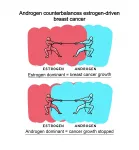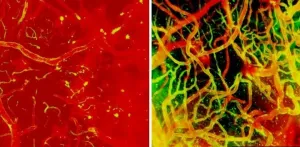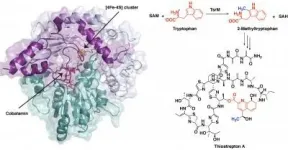(Press-News.org) Indiana Jones and Lara Croft have a lot to answer for. Public perceptions of archaeology are often thoroughly outdated, and these characterisations do little to help.
Yet archaeology as practiced today bears virtually no resemblance to the tomb raiding portrayed in movies and video games. Indeed, it bears little resemblance to even more scholarly depictions of the discipline in the entertainment sphere.
A paper published today in Nature Ecology and Evolution aims to give pause to an audience that has been largely prepared to take such out-of-touch depictions at face value. It reveals an archaeology practiced by scientists in white lab coats, using multi-million-euro instrumentation and state of the art computers.
It also reveals an archaeology poised to contribute in major ways to addressing such thoroughly modern challenges as biodiversity conservation, food security and climate change.
"Archaeology today is a dramatically different discipline to what it was a century ago," observes Nicole Boivin, lead author of the study and Director of the Institute's Department of Archaeology. "While the tomb raiding we see portrayed in movies is over the top, the archaeology of the past was probably closer to this than to present-day archaeology. Much archaeology today is in contrast highly scientific in orientation, and aimed at addressing modern-day issues."
Examining the research contributions of the field over the past few decades, the authors reach a clear conclusion - archaeology today has a great deal to contribute to addressing the challenges of the modern era.
"Humans in the present era have become one of the great forces shaping nature," emphasizes Alison Crowther, coauthor and researcher at both the University of Queensland and the MPI Science of Human History. "When we say we have entered a new, human-dominated geological era, the Anthropocene, we acknowledge that role."
How can archaeology, a discipline focused on the past, hope to address the challenges we face in the Anthropocene?
"It is clear that the past offers a vast repertoire of cultural knowledge that we cannot ignore," highlights Professor Boivin.
The two researchers show the many ways that data about the past can serve the future. By analysing what worked and didn't work in the past - effectively offering long-term experiments in human society - archaeologists gain insight into the factors that support sustainability and resilience, and the factors that work against them. They also highlight ancient solutions to modern problems.
"We show how researchers have improved the modern world by drawing upon information about the ways people in the past enriched soils, prevented destructive fires, created greener cities and transported water without fossil fuels," notes Dr. Crowther.
People also continue to use, and adapt, ancient technologies and infrastructure, including terrace and irrigation systems that are in some cases centuries or even millennia old.
But the researchers are keen to highlight the continued importance of technological and social solutions to climate change and the other challenges of the Anthropocene.
"It's not about glorifying the past, or vilifying progress," emphasizes Professor Boivin. "Instead, it's about bringing together the best of the past, present and future to steer a responsible and constructive course for humanity."
INFORMATION:
Irvine, Calif. -- Future climate change will cause a regionally uneven shifting of the tropical rain belt - a narrow band of heavy precipitation near the equator - according to researchers at the University of California, Irvine and other institutions. This development may threaten food security for billions of people.
In a study published today in Nature Climate Change, the interdisciplinary team of environmental engineers, Earth system scientists and data science experts stressed that not all parts of the tropics will be affected equally. For instance, the rain belt ...
Range anxiety, the fear of running out of power before being able to recharge an electric vehicle, may be a thing of the past, according to a team of Penn State engineers who are looking at lithium iron phosphate batteries that have a range of 250 miles with the ability to charge in 10 minutes.
"We developed a pretty clever battery for mass-market electric vehicles with cost parity with combustion engine vehicles," said Chao-Yang Wang, William E. Diefenderfer Chair of mechanical engineering, professor of chemical engineering and professor of materials science and engineering, and director of the Electrochemical Engine Center at Penn State. "There ...
Targeted neuromodulation tailored to individual patients' distinctive symptoms is an increasingly common way of correcting misfiring brain circuits in people with epilepsy or Parkinson's disease. Now, scientists at UC San Francisco's Dolby Family Center for Mood Disorders have demonstrated a novel personalized neuromodulation approach that -- at least in one patient -- was able to provide relief from symptoms of severe treatment-resistant depression within minutes.
The approach is being developed specifically as a potential treatment for the significant fraction of people with debilitating depression ...
More than 3,000 animal species in the world today are considered endangered, with hundreds more categorized as vulnerable. Currently, ecologists don't have reliable tools to predict when a species may become at risk.
A new paper published in Nature Ecology and Evolution, "Management implications of long transients in ecological systems," focuses on the transient nature of species' and ecosystem stability and illustrates how management practices can be adjusted to better prepare for possible system flips. Some helpful modeling approaches are also offered, including one tool that may help identify potentially ...
Researchers at the University of Adelaide have found new evidence about the positive role of androgens in breast cancer treatment with immediate implications for women with estrogen receptor-driven metastatic disease.
Published today in Nature Medicine, the international study conducted in collaboration with the Garvan Institute of Medical Research, looked at the role of androgens - commonly thought of as male sex hormones but also found at lower levels in women - as a potential treatment for estrogen receptor positive breast cancer.
Watch a video explainer about the new ...
Some of the low-carbon policy options currently used by governments may be detrimental to the households and small businesses less able to manage added short-term costs from energy price hikes, according to a new study.
However, it also suggests that this menu of decarbonising policies, from quotas to feed-in tariffs, can be designed and balanced to benefit local firms and lower-income families - vital for achieving 'Net Zero' carbon and a green recovery.
University of Cambridge researchers combed through thousands of studies to create the most comprehensive analysis to date of widely used types of low-carbon policy, and compared how they perform in areas such as cost and competitiveness. ...
Some of the low-carbon policy options currently used by governments may be detrimental to the households and small businesses less able to manage added short-term costs from energy price hikes, according to a new study.
However, it also suggests that this menu of decarbonising policies, from quotas to feed-in tariffs, can be designed and balanced to benefit local firms and lower-income families - vital for achieving 'Net Zero' carbon and a green recovery.
University of Cambridge researchers combed through thousands of studies to create the most comprehensive analysis to date of widely used types of low-carbon policy, and compared how they perform in areas such ...
Researchers from the National Institutes of Health have discovered Jekyll and Hyde immune cells in the brain that ultimately help with brain repair but early after injury can lead to fatal swelling, suggesting that timing may be critical when administering treatment. These dual-purpose cells, which are called myelomonocytic cells and which are carried to the brain by the blood, are just one type of brain immune cell that NIH researchers tracked, watching in real-time as the brain repaired itself after injury. The study, published in Nature Neuroscience, ...
UNIVERSITY PARK, Pa. -- Images of a protein involved in creating a potent antibiotic reveal the unusual first steps of the antibiotic's synthesis. The improved understanding of the chemistry behind this process, detailed in a new study led by Penn State chemists, could allow researchers to adapt this and similar compounds for use in human medicine.
"The antibiotic thiostrepton is very potent against Gram-positive pathogens and can even target certain breast cancer cells in culture," said Squire Booker, a biochemist at Penn State and investigator with the Howard Hughes Medical Institute. "While it has been used ...
HOUSTON — In an effort to address a major challenge when analyzing large single-cell RNA-sequencing datasets, researchers from The University of Texas MD Anderson Cancer Center have developed a new computational technique to accurately differentiate between data from cancer cells and the variety of normal cells found within tumor samples. The work was published today in Nature Biotechnology.
The new tool, dubbed CopyKAT (copy number karyotyping of aneuploid tumors), allows researchers to more easily examine the complex data obtained from large single-cell RNA-sequencing experiments, which deliver gene expression data from ...






